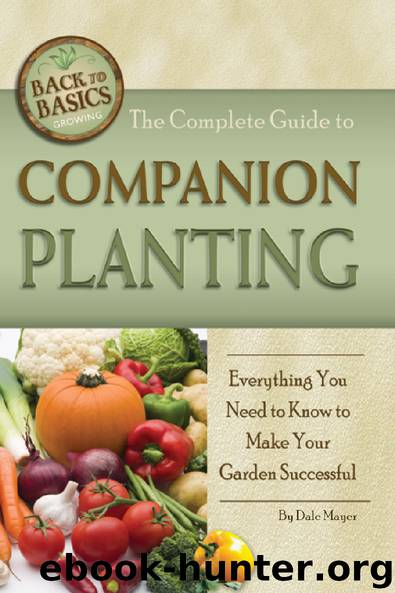The Complete Guide to Companion Planting: Everything You Need to Know to Make Your Garden Successful by Dale Mayer

Author:Dale Mayer
Language: eng
Format: epub
Tags: planting, gardening, fruits, vegetables, harvest, pests, shrubs, vines, produce, flowers, containers, crops, annuals, perennials, schedule
Publisher: Atlantic Publishing
Published: 2012-01-08T00:00:00+00:00
Lavender is an easy to grow plant with few known pests of its own. It is a small shrub with gray leaves and violet flowers that is known for its pleasant, sweet scent. The fresh and dried flowers are used in for various things including scent pouches. The flowers can be candied and used in baking, and its leaves and flowers are used in home remedies and aromatherapy. You can start cuttings in the fall indoors or purchase plants from garden centers and plant in the spring. It is harder to grow this plant from seed. Lavender prefers alkaline soil and a sunny location. The plant also does not like a lot of water so it will not do well close to sprinklers, low ground, or beside plants that require a lot of water. It is a long lived perennial that lives an average of ten years. You should space these plants several feet apart.
The constant flowering aspect of the lavender attracts and nourishes many insects. It protects other plants from whitefly and when planted close to fruit trees, it will deter codling moths. It is considered deer resistant and rabbit resistant but will attract butterflies. It is a good companion to dianthus, yucca, daylily, coreopsis, and yarrow, and there are no known bad companions.
Lemon Balm (Melissa officinalis)
Lemon balm can easily grow 3 to 4 feet, producing leaves containing a gentle lemon scent. The plant produces white flowers toward the end of summer. Lemon balm is used in herbal teas and desserts, as well as many medicinal uses. The lemon balm herb requires moist soil and a full-sun or partial-sun location. You can plant seeds or propagate by cutting off a large piece of root from an existing plant. The seedlings should be no closer than 2 feet and you should make the rows 2 feet apart as well. The plants will grow quickly.
The plant is easily recognizable by its lemon-scented foliage and has similar compounds to the citronella plant, which helps this plant keep the mosquitoes away. Rub the leaves and the mosquitoes will avoid you. It also repels squash bugs, which makes it a good companion plant for squash and pumpkin plants. There are no known bad companions for this plant.
Lovage (Levisticum officinale)
Lovage is a large perennial plant, reaching 6 feet in height, so plan to give it space in the garden. It has ribbed stalks and hollow stems with dark green leaves and yellow flowers. Lovage tastes similar to celery and parsley whereas the roots have a nutty flavor. It prefers shady, slightly moist conditions. It can be planted in spring or sown in late summer and early fall for sprouting the following spring. Lovage will die down every winter and spring up again the following year.
Lovage improves the flavor and vigor of most plants and offers a good habitat for ground beetles. Lovage is a good companion plant for cucumbers, asparagus, beans, beets, the brassica family, onion, leeks, peas, potatoes, lettuce, squash, zucchini, corn, and tomatoes. It is not considered a good companion for celery.
Download
This site does not store any files on its server. We only index and link to content provided by other sites. Please contact the content providers to delete copyright contents if any and email us, we'll remove relevant links or contents immediately.
Periodization Training for Sports by Tudor Bompa(7327)
The MacArthur Bible Commentary by John MacArthur(4236)
The Body: A Guide for Occupants by Bill Bryson(3797)
The Sports Rules Book by Human Kinetics(3587)
What It Really Takes to Get Into Ivy League and Other Highly Selective Colleges by Hughes Chuck(3220)
Marijuana Grower's Handbook by Ed Rosenthal(3117)
The Sprouting Book by Ann Wigmore(3052)
Salt, Fat, Acid, Heat: Mastering the Elements of Good Cooking by Nosrat Samin(2658)
The Martian by Andy Weir(2609)
Classic by Mary Berry(2501)
The Bread Bible by Rose Levy Beranbaum(2470)
Harry Potter 4 - Harry Potter and The Goblet of Fire by J.K.Rowling(2416)
The Marketing Plan Handbook: Develop Big-Picture Marketing Plans for Pennies on the Dollar by Robert W. Bly(2413)
Sapiens and Homo Deus by Yuval Noah Harari(2411)
Martha Stewart's Baking Handbook by Martha Stewart(2330)
50 Economics Classics by Tom Butler-Bowdon(2066)
Screenplay: The Foundations of Screenwriting by Syd Field(2056)
The Cambridge Grammar Of The English Language by Rodney Huddleston Geoffrey K. Pullum(2046)
The Plant Paradox by Dr. Steven R. Gundry M.D(2038)
